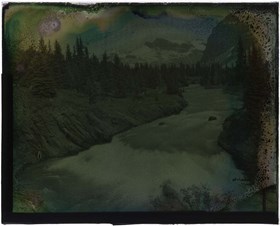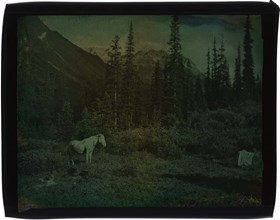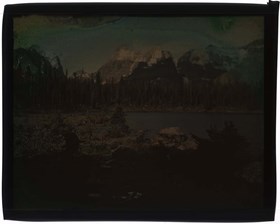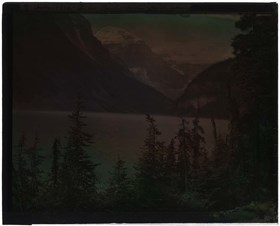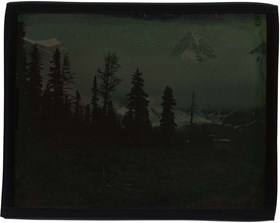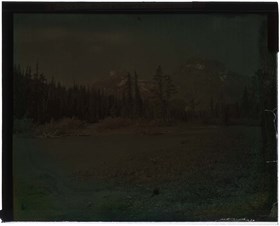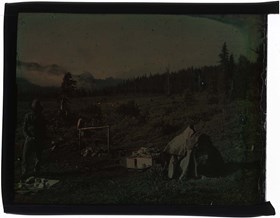Narrow Results By
Lantern Slides
https://archives.whyte.org/en/permalink/descriptions54147
- Part Of
- Stan J. Carr fonds
- Scope & Content
- File consists of 8 colour lantern slides, some captioned. File subjects include an unidentified mountain scene, Mount Assiniboine, horse in unientified mountain scene, man posed in campsite in unidentified location, Lake Louise and Victoria Glacier, Hector Lake and Bow Peak, unidentified man in cam…
- Date Range
- ca. 1912
- Reference Code
- V127 / PS - 1 to 8
- Description Level
- 5 / File
- GMD
- Transparency
- Lantern slide
8 images
- Part Of
- Stan J. Carr fonds
- Description Level
- 5 / File
- Fonds Number
- M 179
- V 127
- Sous-Fonds
- V 127
- Accession Number
- 1072
- Reference Code
- V127 / PS - 1 to 8
- Date Range
- ca. 1912
- Physical Description
- 8 photographs : col. slides ; 10.5 x 14 cm
- History / Biographical
- Additive Colour Screen Plates, first theorized by James Clerk Maxwell in 1861, were the first forms of colour photography. Maxwell’s original process involved printing the same black and white image through different coloured screens onto transparencies and then projecting them overlapped in order to create a single full-colour image. In 1868 Louis Ducos du Hauron expanded on this method by placing a screen made up of microscopic coloured stripes in front of a light-sensitive emulsion before exposing it to light. During exposure, the colours in the screen attached to the developing picture so when viewed back through the screen in a projector the image appeared fully in colour. Neither of these methods were commercially popular during the 19th century since black and white processes were cheaper and more widely available. In 1907 the Lumiere brothers introduced the Autochrome process to wide commercial success. The Autochrome process involved a mix of tiny potato starch grains dyed green, orange-red, and blue-purple that were mixed thoroughly and applied to a glass slide coated in a sticky varnish that held the grains in an evenly-distributed layer. The grains were laminated into the varnish to make them smaller and more transparent, and then the whole thing was sealed with another layer of waterproof varnish. The entire process could be done by machines, which made the slides cheap to produce, easily available to the public and opened up the process to amateur photographers. Photographs developed on Autochrome plates created soft images with relatively natural colour rendering, making them popular with artists and photojournalists. Autochrome plates (which came to refer to all colour screen plates regardless of manufacturer) created one-of-a-kind positive images and required long exposure times. Once an image was complete, it had to be quickly covered with either a strong coating of varnish or another slide of glass and then sealed along the edges with binding tape. Because silver is an element of the sticky base varnish that holds the dyed grains, if moisture was allowed to access the image the layers of varnish could ripple or tear away from the glass, or the dye could bleed or fade. The silver base is highly sensative to oxygen and if improperly sealed images could begin to "mirror," a process in which the exposed parts of the slide become uniform and shiny, obscuring the image. Because of the random distribution of dyed colour grains throughout the image and the lines created by laminating those grains into the base varnish, Autochrome transparencies are often mistaken for hand-painted coloured slides. Autochrome can be identified by looking closely for small dots of colour in all parts of the image, rather than the solid blots of colour found on hand-painted slides.
- Scope & Content
- File consists of 8 colour lantern slides, some captioned. File subjects include an unidentified mountain scene, Mount Assiniboine, horse in unientified mountain scene, man posed in campsite in unidentified location, Lake Louise and Victoria Glacier, Hector Lake and Bow Peak, unidentified man in camp.
- Name Access
- Carr, Stan J.
- Subject Access
- Exploration
- Discovery and travel
- Lantern slide
- Geographic Access
- Mount Assiniboine
- Lake Louise
- Bow Summit
- Banff National Park
- Alberta
- Canada
- Access Restrictions
- No restrictions on access
- Language
- English
- Conservation
- Re-seal all slides appropriately; keep stored in cool, dry, dark area; refrain from exposing to further damage.
- Creator
- Carr, Stan J.
- Category
- Exploration, discovery and travel
- Biographical Source Notes
- http://www.graphicsatlas.org/identification/?process_id=286#overview
- https://psap.library.illinois.edu/collection-id-guide/slide#autochrome
- Title Source
- Title based on contents of file
- Processing Status
- Processed
Images
This material is presented as originally created; it may contain outdated cultural descriptions and
potentially offensive content.
Read more.
Stan J. Carr fonds
https://archives.whyte.org/en/permalink/descriptions129
- Part Of
- Stan J. Carr fonds
- Scope & Content
- Fonds consists of guiding papers, 1913-1938, pertaining mainly to the Half Diamond M Ranch at Tete Jaune Cache; poems, n.d., 1910, 1940; lengthy manuscript by S. Knapp, ca.1920, titled "Camping with Windy: Tales of the Canadian Rockies"; and photographs pertaining to Carr, associates, clients and p…
- Date Range
- 1910-1976
- Reference Code
- M179 / V127
- Description Level
- 1 / Fonds
- GMD
- Photograph
- Album
- Photograph print
- Transparency
- Textual record
- Private record
- Part Of
- Stan J. Carr fonds
- Description Level
- 1 / Fonds
- Fonds Number
- M 179
- V 127
- Sous-Fonds
- M 179
- V 127
- Accession Number
- 1072, 2108, 2370, 2589
- Reference Code
- M179 / V127
- Date Range
- 1910-1976
- Physical Description
- 2 cm of textual records. -- 1 photograph album (134 prints). -- 70 photographs : prints, transparencies
- History / Biographical
- Stan J. "Windy" Carr, 1890-1983, was a guide and outfitter and dude ranch owner at Lake Louise, Alberta and Tete Jaune Cache, British Columbia, Canada. Carr, an English immigrant, began working for Brewster Transport Co. at Lake Louise in 1910. He worked as a pony-boy around Lake Louise and began leading pack train trips. Rev. Dr. S. Knapp, Worcester, Massachusetts was a client for thirty years. Carr later operated the Half Diamond M ranch near Tete Jaune Cache, B.C.
- Scope & Content
- Fonds consists of guiding papers, 1913-1938, pertaining mainly to the Half Diamond M Ranch at Tete Jaune Cache; poems, n.d., 1910, 1940; lengthy manuscript by S. Knapp, ca.1920, titled "Camping with Windy: Tales of the Canadian Rockies"; and photographs pertaining to Carr, associates, clients and pack trips, 1910-1914. Knapp manuscript discusses camping trips in the vicinities of Bow Lake, Lake O'Hara, Mount Assiniboine, Lake Louise, Pipestone Valley and Kananaskis Lakes and includes notes by Carr, 1976.
- Photograph album pertains to horse ranching and horses at Springbank and Calgary, and Brewster horse staff and kitchen staff? at Lake Louise Chalet, ca.1910.
- Name Access
- Carr, Stan J.
- Subject Access
- Exploration, discovery and travel
- Access Restrictions
- No restrictions on access
- Copyright, privacy, commercial use and other restrictions may apply
- Language
- Language is English
- Finding Aid
- Finding aids and reference tools: basic description for prints and album pages
- Creator
- Carr, Stan J.
- Category
- Exploration, discovery and travel
- Title Source
- Title based on contents of fonds
- Processing Status
- Processed
This material is presented as originally created; it may contain outdated cultural descriptions and
potentially offensive content.
Read more.
Vaux family fonds
https://archives.whyte.org/en/permalink/descriptions391
- Part Of
- Vaux family fonds
- Scope & Content
- Fonds consists of two or more series. Series I. Photography, 1893-1913, is processed. Series II. Textual records are processed and consist of six series. Photography series consists of twenty-four sub-series: A. to O. Travel 1893 to Travel 1907; P. to S. Travel 1909 to Travel 1913; T. Travel ge…
- Date Range
- [after 1855]
- Reference Code
- M107 / V653
- Description Level
- 1 / Fonds
- GMD
- Photograph
- Album
- Negative
- Photograph print
- Transparency
- Textual record
- Map
- Private record
- Published record
- Part Of
- Vaux family fonds
- Description Level
- 1 / Fonds
- Fonds Number
- M 107
- V 653
- Sous-Fonds
- M 107
- V 653
- Accession Number
- 739, 1117, 1118, 1793, 2883, 3236, 3942, 4012, 7202, 7579 (unproc), 7792 (unproc)
- Reference Code
- M107 / V653
- GMD
- Photograph
- Album
- Negative
- Photograph print
- Transparency
- Textual record
- Map
- Private record
- Published record
- Date Range
- [after 1855]
- Physical Description
- 2924 photographs: 2632 negatives, 167 transparencies, 125 prints. -- 1 photograph album (50 prints). -- ca.2.7 m textual records
- History / Biographical
- The Vaux family of Philadelphia, Pennsylvania were photographers, mountaineers and scientists. Mary M. Vaux, 1860-1940, George Vaux Jr., 1863-1927, and William S. Vaux Jr., 1872-1908, were the children of George Vaux (VIII) of Philadelphia. They were all involved in photography in the early 1880s and were members of the Photographic Society of Philadelphia. All three were taking photographs when the family made its first trip west in 1885. The first Vaux family photographs of the Canadian mountain west were made in 1887 during a summer trip along the Canadian Pacific Railway to Glacier House in the Selkirk Mountains of British Columbia in 1887.
- The family made frequent visits to the Selkirk and Rocky Mountains over the next two decades to study the Illecillewaet and other glaciers, photograph, paint and climb. George's and Mary's photographic work centred on the mountain landscape, while William's concentrated upon the movement and physical features of glaciers. Due to the size of their large format cameras, the two brothers took most of the photographs during these trips and Mary was responsible for all of the printing. William Vaux died in 1908 and George did not return to the Canadian mountains after 1911; however, Mary Vaux Walcott returned to the region virtually every summer for over forty years. A detailed discussion of their activities is contained in "Legacy In Ice: The Vaux Family and the Canadian Alps," Whyte Foundation, Banff, 1983
- Scope & Content
- Fonds consists of two or more series. Series I. Photography, 1893-1913, is processed. Series II. Textual records are processed and consist of six series.
- Photography series consists of twenty-four sub-series: A. to O. Travel 1893 to Travel 1907; P. to S. Travel 1909 to Travel 1913; T. Travel general, 1894?-1912?; U. Prints, 1899-1907; V. Lantern slides, 1900-1909; W. Photograph album, before 1907; X. Textual records, 1893-1910; Y. Damaged Negatives; Z. Mary Schaffer Negatives. Photographic negatives, arranged chronologically, are prominent in the series. Images pertain to landscape studies and scenic views of the Selkirk and Rocky Mountains, especially the Glacier, Yoho and Lake Louise areas; glaciers in the Selkirk and Rocky Mountains, especially Illecillewaet, Asulkan, Yoho and Bow Glaciers; mountain scenes and panorama views in the Selkirks and Rockies; Canadian Pacific Railway in the Selkirks and CPR hotels; Glacier and Field, B.C. and Banff, Alberta and areas; climbing and other mountain activities; United States and Canadian views on trips to the mountains. Negatives include both glass (962 items) and film negatives (1740 items). Textual records are exposure records, original negative envelopes and publications.
- Textual series consists of six series: I. Trip Series, II. Correspondence Series, III. Publications Series, IV. George Vaux: Legal and Finance Management Series, V. Photographic Related Material, VI. Other Series (O.S.). Textual records pertain to glacier study, including research papers, maps and publications; William S. Vaux Jr. papers re travels, engineering and architecture, other; George Vaux Jr. writing and other papers; Mary Vaux correspondence and papers re writing and presentations; and other records, 1877, 1912-1913. Textual records also include family travel papers, 1881-1911; George Vaux, Jr. "Glacier" files; correspondence between George Vaux and the Schäffers, 1899-1926; papers of Dr. Charles Schäffer, Mary Schäffer and Schäffer estate, 1855-1927.
- Subject Access
- Environment
- Exploration, discovery and travel
- Family and personal life
- Access Restrictions
- Some restriction/s on access
- Copyright, privacy, commercial use and other restrictions may apply
- Language
- Language is English
- Finding Aid
- Finding aids and reference tools: arrangement outline
- series description
- file description for Series I
- electronic finding aid for Series I
- selected modern reference prints
- digital images in Images database and in Alberta InSight database
- Related Material
- Related by provenance to the Vaux family collection of photographs held by the Library Company of Philadelphia and the Vaux collection of correspondence, documents and graphics held by Special Collections of Haverford College Library, Haverford, Pennsylvania
- Creator
- Vaux, George
- Vaux, Mary
- Vaux, William
- Title Source
- Title based on contents of fonds
- Processing Status
- Processed
This material is presented as originally created; it may contain outdated cultural descriptions and
potentially offensive content.
Read more.

